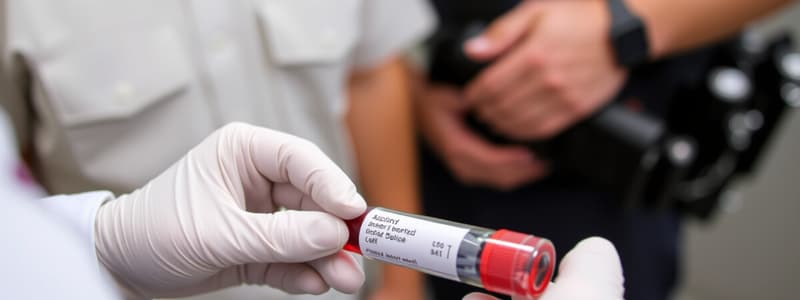Podcast
Questions and Answers
What must the accused be over to be charged under section 5?
What must the accused be over to be charged under section 5?
- A prescribed limit for alcohol or drugs (correct)
- A personal threshold of ability
- A standard measure of impairment
- A prescribed speed limit
Which factor is NOT considered a common cause of driver impairment?
Which factor is NOT considered a common cause of driver impairment?
- Medical conditions
- Fatigue
- Alcohol consumption
- Excessive speed (correct)
What should be considered if a driver behaves as if impaired but does not show signs of alcohol or drug use?
What should be considered if a driver behaves as if impaired but does not show signs of alcohol or drug use?
- They could be playing loud music
- They might have a medical condition (correct)
- They could be under stress from work
- They may have mental health issues
What immediate action might be necessary if there's doubt about a driver's impairment?
What immediate action might be necessary if there's doubt about a driver's impairment?
Why should the vehicle be checked if a driver appears drunk?
Why should the vehicle be checked if a driver appears drunk?
Which of the following conditions can mimic the effects of alcohol or drug impairment?
Which of the following conditions can mimic the effects of alcohol or drug impairment?
Under what circumstance should a police officer consider the driver's vehicle when addressing impairment?
Under what circumstance should a police officer consider the driver's vehicle when addressing impairment?
What is a misconception about driver impairment that can lead to incorrect assessments?
What is a misconception about driver impairment that can lead to incorrect assessments?
What should happen if a driver is found to be impaired?
What should happen if a driver is found to be impaired?
Which of the following is required at the police station after an arrest for a Section 4 offence?
Which of the following is required at the police station after an arrest for a Section 4 offence?
Under what condition can police arrest a person concerning preliminary impairment tests?
Under what condition can police arrest a person concerning preliminary impairment tests?
When is a breath specimen not required at the police station?
When is a breath specimen not required at the police station?
What must police do before conducting examinations and tests on the accused at the station?
What must police do before conducting examinations and tests on the accused at the station?
What is the purpose of the preliminary impairment tests?
What is the purpose of the preliminary impairment tests?
What options do police have if breath analysis machinery is not available?
What options do police have if breath analysis machinery is not available?
What is the significance of the results from examinations and tests conducted at the police station?
What is the significance of the results from examinations and tests conducted at the police station?
What must be proven for an offence under Section 4 of the RTA 1988?
What must be proven for an offence under Section 4 of the RTA 1988?
Which of the following vehicles is included in the definition of 'mechanically propelled vehicle' under Section 4 RTA 1988?
Which of the following vehicles is included in the definition of 'mechanically propelled vehicle' under Section 4 RTA 1988?
What distinguishes the Section 4 offence from Section 5 regarding driving under the influence?
What distinguishes the Section 4 offence from Section 5 regarding driving under the influence?
What types of substances can cause impairment for a Section 4 offence?
What types of substances can cause impairment for a Section 4 offence?
What is a requirement for a police officer performing duties related to a Section 4 offence?
What is a requirement for a police officer performing duties related to a Section 4 offence?
Which scenario would most directly lead to arrest under Section 4 RTA 1988?
Which scenario would most directly lead to arrest under Section 4 RTA 1988?
Which of the following is clearly not covered under Section 4 of the RTA 1988?
Which of the following is clearly not covered under Section 4 of the RTA 1988?
What impact does a conviction under Section 4 of the RTA 1988 have on future driving permissions?
What impact does a conviction under Section 4 of the RTA 1988 have on future driving permissions?
What does Section 5A of the Road Traffic Act 1988 specifically address?
What does Section 5A of the Road Traffic Act 1988 specifically address?
Which type of test is primarily used to detect drugs under Section 5A?
Which type of test is primarily used to detect drugs under Section 5A?
What happens if a drugwipe test is negative?
What happens if a drugwipe test is negative?
What must be shown for a Section 4 procedure to be initiated?
What must be shown for a Section 4 procedure to be initiated?
Under Section 5A, which of the following statements is true?
Under Section 5A, which of the following statements is true?
What is required for a driver to be charged under Section 5A?
What is required for a driver to be charged under Section 5A?
Which section of the Road Traffic Act relates to a person unfit due to drink or drugs?
Which section of the Road Traffic Act relates to a person unfit due to drink or drugs?
How are the drug limits set under Section 5A defined?
How are the drug limits set under Section 5A defined?
What is the function of an appropriately trained nurse in relation to a Section 5A arrest?
What is the function of an appropriately trained nurse in relation to a Section 5A arrest?
Which substance has the lowest blood limit according to the content provided?
Which substance has the lowest blood limit according to the content provided?
What is the required blood limit for Diazepam as per the guidelines?
What is the required blood limit for Diazepam as per the guidelines?
The procedure to be followed at a police station after a Section 4 arrest requires which of the following?
The procedure to be followed at a police station after a Section 4 arrest requires which of the following?
Which of the following substances does not require a medical professional to take a blood sample after an arrest?
Which of the following substances does not require a medical professional to take a blood sample after an arrest?
Under Section 5A of the Road Traffic Act, which drug has the highest acceptable blood limit?
Under Section 5A of the Road Traffic Act, which drug has the highest acceptable blood limit?
What is a key requirement for officers testing substances in relation to a Section 5A arrest?
What is a key requirement for officers testing substances in relation to a Section 5A arrest?
Which of the following drugs has the blood limit set at 20ug?
Which of the following drugs has the blood limit set at 20ug?
Which statement about substances specified in Section 5A is correct?
Which statement about substances specified in Section 5A is correct?
Which of the following statements regarding Section 4 and 5A arrests is incorrect?
Which of the following statements regarding Section 4 and 5A arrests is incorrect?
Flashcards are hidden until you start studying
Study Notes
Police Station Procedure for Arrest in Drink or Drug Driving Cases
- A person arrested for driving while unfit must be processed at the police station.
- The arrested individual must provide either a breath, blood, or urine sample for analysis.
- Breath analysis is preferred, using a machine unless unavailable or if the individual has a reasonable excuse for refusal.
- If suspected solely of drug impairment, a breath specimen is not required.
- Consent for examination and testing should be explicitly requested from the arrested individual.
- It must be clarified that test results may be used as evidence and compliance is not compulsory.
Offence Under Section 5A of the Road Traffic Act 1988
- Section 5A addresses driving with specified drugs in the system, exceeding legal limits.
- This law applies even when no visible signs of impairment are present.
- The offence includes driving, attempting to drive, or being in charge of a vehicle with specified drugs in concentrations above established thresholds.
- Established limits apply specifically to blood concentrations; 17 drugs are regulated under this section with defined limits.
- Procedures for compliance include specimen collection (saliva for initial tests) and power of arrest if necessary.
- Drugwipe tests are used to detect Cannabis and Cocaine, but a negative result halts further action unless impairment is indicated.
- Unlike Section 4, no requirement exists for a medical doctor’s opinion; trained nurses can take blood samples.
Key Comparisons - Section 4 vs. Section 5A
- Section 4 focuses on driving impairment due to substances while Section 5A centers on exceeding drug limits regardless of impairment.
- Section 4 requires proving unfitness due to drink or drugs, while Section 5A focuses solely on the presence of drugs above specified limits.
- Both sections require testing and specimen collection but differ in processes regarding medical evaluations.
Studying That Suits You
Use AI to generate personalized quizzes and flashcards to suit your learning preferences.



